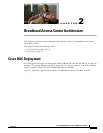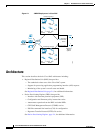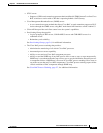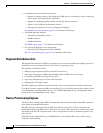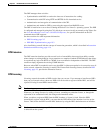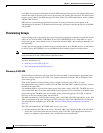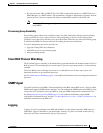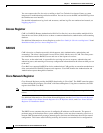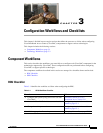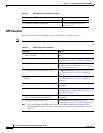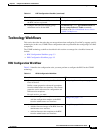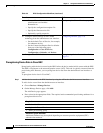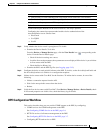
2-8
Cisco Broadband Access Center 3.8 Administrator Guide
OL-27172-01
Chapter 2 Broadband Access Center Architecture
Architecture
You can compress the files for easier e-mailing to the Cisco Technical Assistance Center or system
integrators for troubleshooting and fault resolution. You can also access the RDU and the DPE logs from
the administrator user interface.
For detailed information on log levels and structures, and how log files are numbered and rotated, see
Logging, page 21-2.
Access Registrar
CAR is a RADIUS (Remote Authentication Dial-In User Service) server that enables multiple dial-in
Network Access Server (NAS) devices to share a common authentication, authorization, and accounting
database.
For additional information on Access Registrar, see the User Guide for Cisco Access Registrar 5.0 and
Installation Guide for Cisco Access Registrar 5.0.
RADIUS
CAR is based on a client/server model, which supports AAA (authentication, authorization, and
accounting). The client is the Network Access Server (NAS) and the server is CAR. The client passes
user information onto the RADIUS server and acts on the response it receives.
The server, on the other hand, is responsible for receiving user access requests, authenticating and
authorizing users, and returning all necessary configuration information that the client can then pass on
to the user.
Cisco BAC now supports RADIUS for device authentication. CAR provides an extension mechanism to
allow customization of RADIUS requests and responses. Cisco BAC handles the Authentication and
Authorization request through this extension.
Cisco Network Registrar
Cisco Network Registrar provides the DHCP functionality in Cisco BAC. The DHCP extension points
on Network Registrar integrate Cisco BAC with Network Registrar. Using these extensions, the CNR
registers itself with Cisco BAC.
Note Cisco Network Registrar (CNR) is re-branded to Cisco Prime Network Registrar starting with the 8.0
release.
For additional information on Cisco Prime Network Registrar, see the Cisco Prime Network Registrar
8.1 User Guide, Cisco Prime Network Registrar 8.1 CLI Reference Guide, and Cisco Prime Network
Registrar 8.1 Installation Guide.
DHCP
The DHCP server automates the process of configuring IP addresses on IP networks. The protocol
performs many of the functions that a system administrator carries out when connecting a device to a
network. DHCP automatically manages network-policy decisions and eliminates the need for manual
configuration. This feature adds flexibility, mobility, and control to networked device configurations.




